One of Debora Fadul’s earliest childhood memories is traveling in the backseat of her family’s sedan as her father negotiated long, windy roads to far-flung and verdant villages in Guatemala’s interior. In the countryside, her father trained schoolteachers to become better educators while Fadul absorbed knowledge about the richness of Guatemala’s culture, the people, the land and the food it produces.
These trips are a big reason Fadul, now 37, became obsessed at a young age with the ingredients that became her meals — and they’re likely why she became a chef.
At her restaurant Diacá, in Guatemala City, she is at the forefront of a movement to reacquaint Guatemalans with their culinary heritage and reconnect this Central American country of 17 million consumers with its farmers and their produce, much of it deeply rooted in its many Indigenous cultures.
Jaime Antillon, left, and Emily Meza in the kitchen at Debora Fadul’s Diaca restaurant in Guatemala City.
(James Rodriguez / For The Times/James Rodriguez/Los Angeles Times)
She describes Diacá’s food as cocina explorativa de raíz, or exploratory cuisine from the root, with ancient and native produce central to many of the dinner courses on her seasonally focused tasting menus and a la carte lunch dishes.
Nearly all of the ingredients she cooks with are from Guatemala. Many have long been used by Indigenous people.
Her efforts haven’t gone unnoticed. In 2023, she earned her highest ranking, No. 76, on the Best Chef Top 100 list, voted on by restaurant industry professionals and members of the media. She was No. 98 on the list in 2022, the same year she was recognized on the “50 Next” list for hospitality pioneers by the group that administers the annual World’s 50 Best Restaurants list. That organization also ranked Diacá No. 47 on its 2022 list of Latin America’s 50 Best Restaurants and No. 52 in 2023.
The accolades have drawn many diners — particularly international travelers — to Diacá. Yet while Fadul appreciates the many foreigners who make the pilgrimage to Guatemala City, her target diners are her country’s people.
“In Guatemala, the Chapín is a tourist in his own country,” says Fadul, using the slang term, often spoken with pride, for her fellow citizens. “Guatemalans don’t know what there is or what he or she eats. I want them to reassess, appreciate and honor these ingredients … to be proud of what we have here.”
Her mission is no small feat.
Guatemalans, Fadul says, tend to place more value on food imported from the United States or Europe rather than their own country’s products.
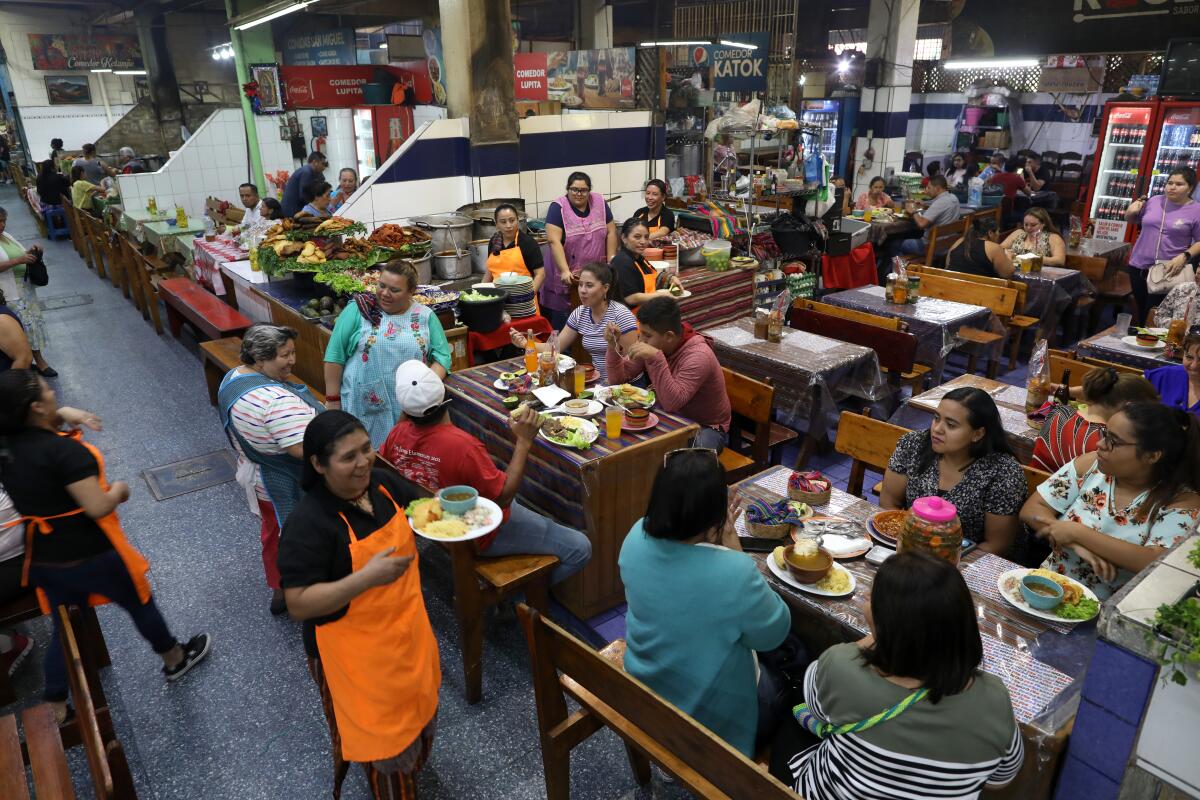
Guests eat in a food court with a variety of different restaurants at the Central Market in Guatemala City in 2020. (Gary Coronado / Los Angeles Times)
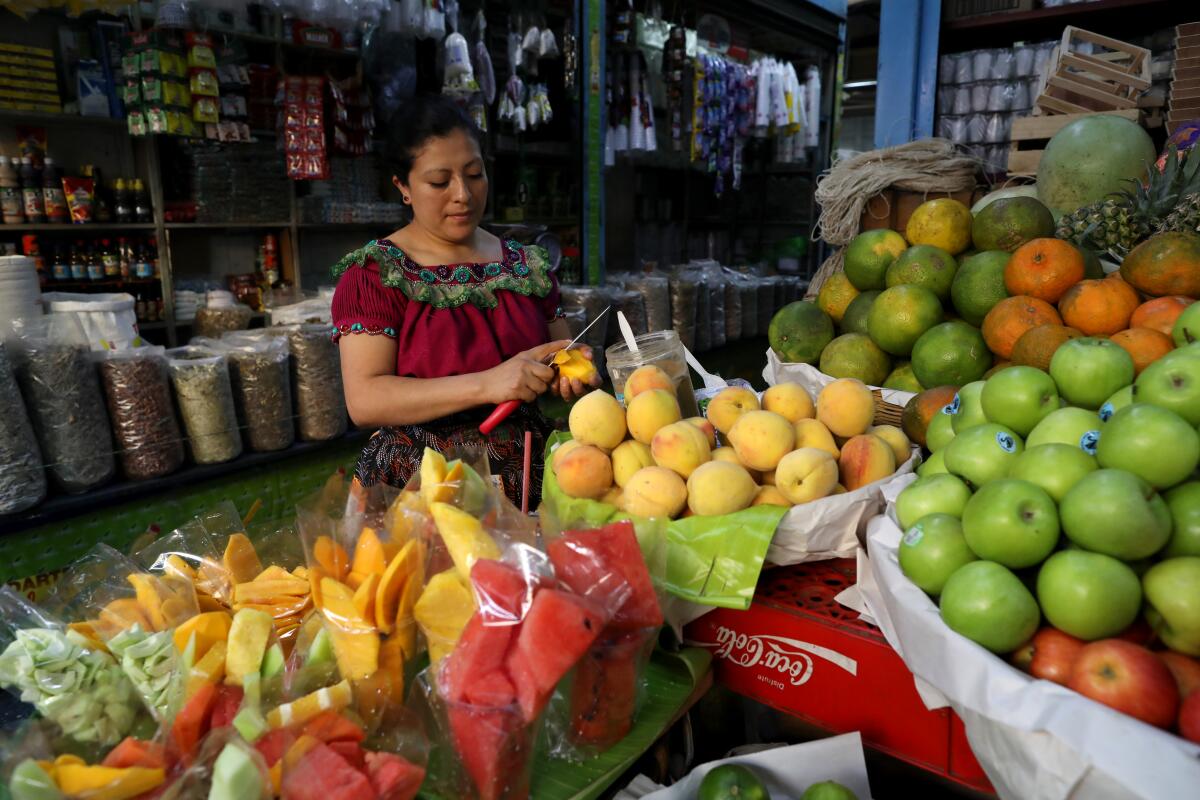
Anabella Juarez prepares cut mango in the Central Market in Guatemala City. (Gary Coronado / Los Angeles Times)
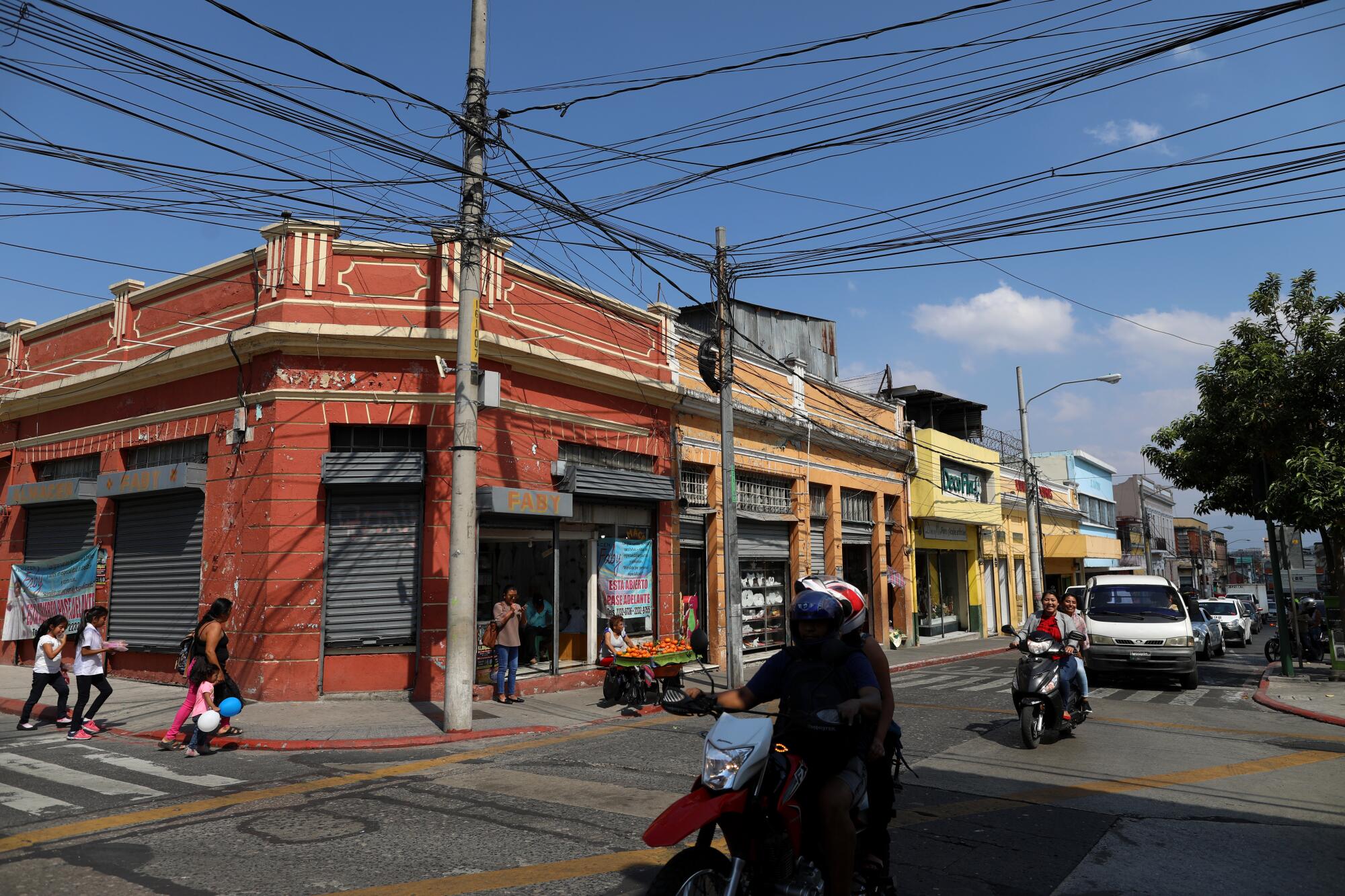
Calle 6A near the Central Market in the Historic Center in Zona 1 in Guatemala City in 2020.
(Gary Coronado / Los Angeles Times)
Although there are an estimated two dozen Indigenous languages spoken in Guatemala and Indigenous people make up more than half the population, they are still considered an underclass by many in the country.
Inequality and discrimination against Indigenous people runs deep, and that sentiment extends to viewing Indigenous foods and practices as primitive or inferior.
Fadul is trying to change the narrative and encourage Guatemalans to appreciate their Mesoamerican roots and to stop looking abroad for inspiration.
“We need to educate the consumer,” she likes to say.
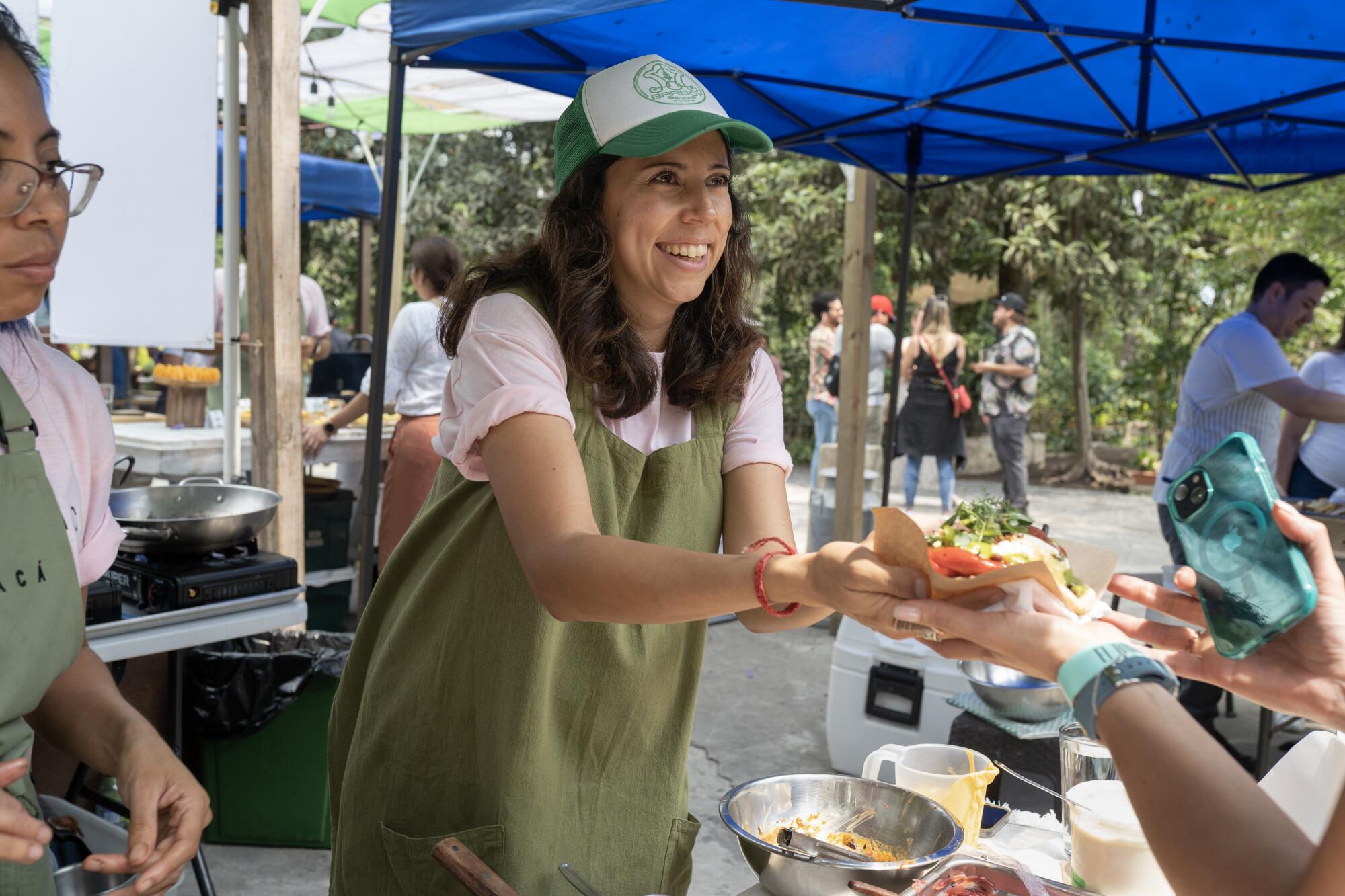
Chef Debora Fadul serves her own take on a chile relleno at a food festival in Antigua.
(James Rodriguez / For The Times/James Rodriguez/Los Angeles Times)
In the fields
On a breezy spring morning Fadul and Christian Paz, her husband and partner at Diacá, meet with Juan Manuel Perez, a 35-year-old grower on his land at Tikonel Farms near Antigua, the nation’s former capital.
Fadul, petite and energetic, makes it a point to personally visit each of her producers or ensure that someone on her team does. She feels it’s important for the cook to have a relationship with not only the produce but also the land and the people who tend it.
“There is a disconnect,” she says, “between the consumers and the producers.”
At Tikonel Farms it’s immediately clear as Fadul and Paz walk the land with Perez that conventional agriculture techniques are not practiced here. Not one neatly manicured furrow of bare soil is in sight.
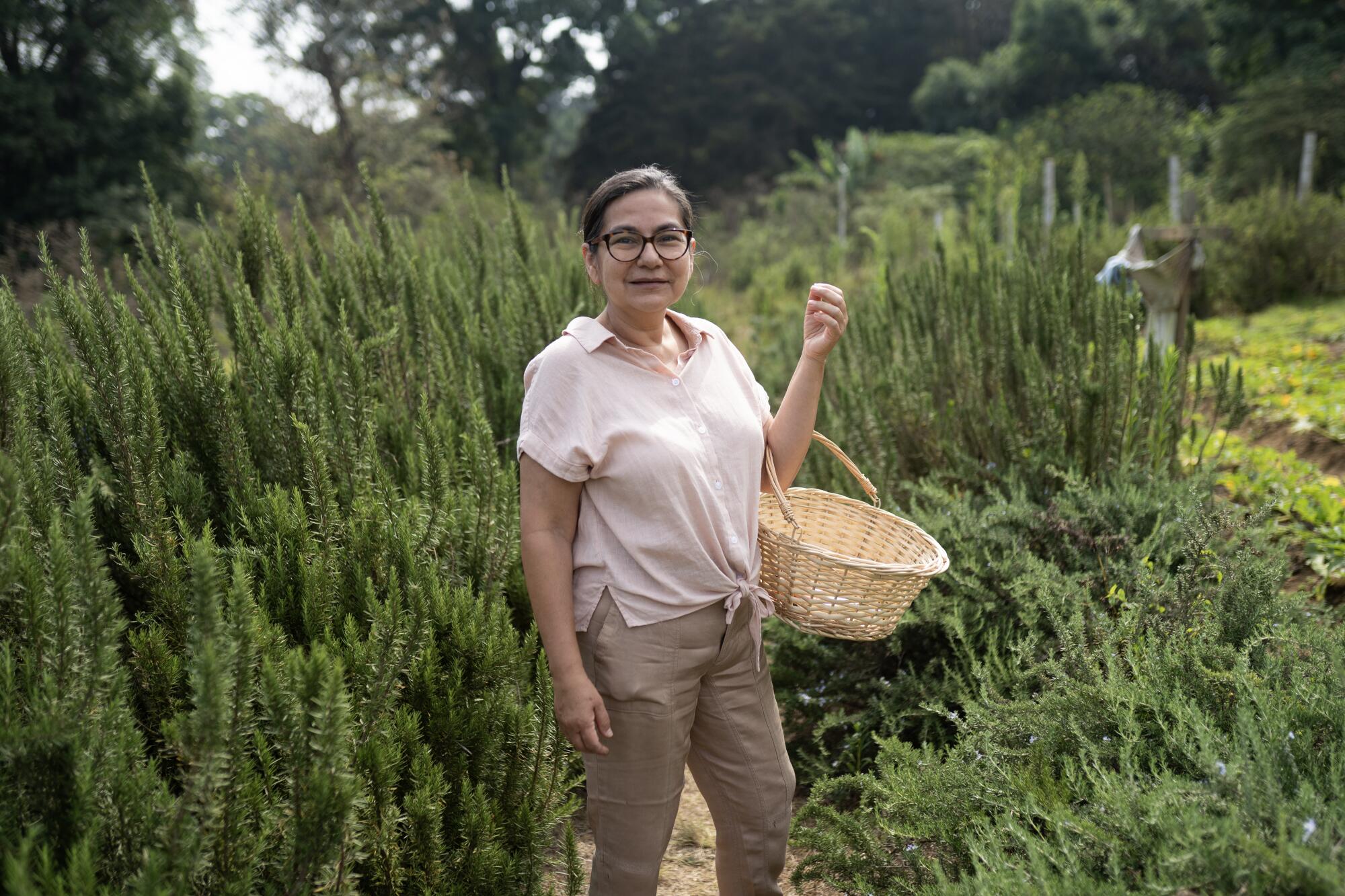
Ana Virginia Juarez of Tikonel Farms in Santa Lucia Milpas Altas, in an area where the crops meet the forest.
(James Rodriguez / For The Times)
That’s because Perez practices regenerative farming, which tends to look a bit messy but creates the healthiest soil for his organic produce.
Guatemala is blessed with nutrient-rich volcanic soil and unique microclimates that create ideal growing conditions for thousands of herbs, legumes, grains, fruits, vegetables and fungi — most of them native or endemic to Guatemala or Mesoamerica. But years of conventional monoculture agriculture and the effects of climate change have damaged the soil.
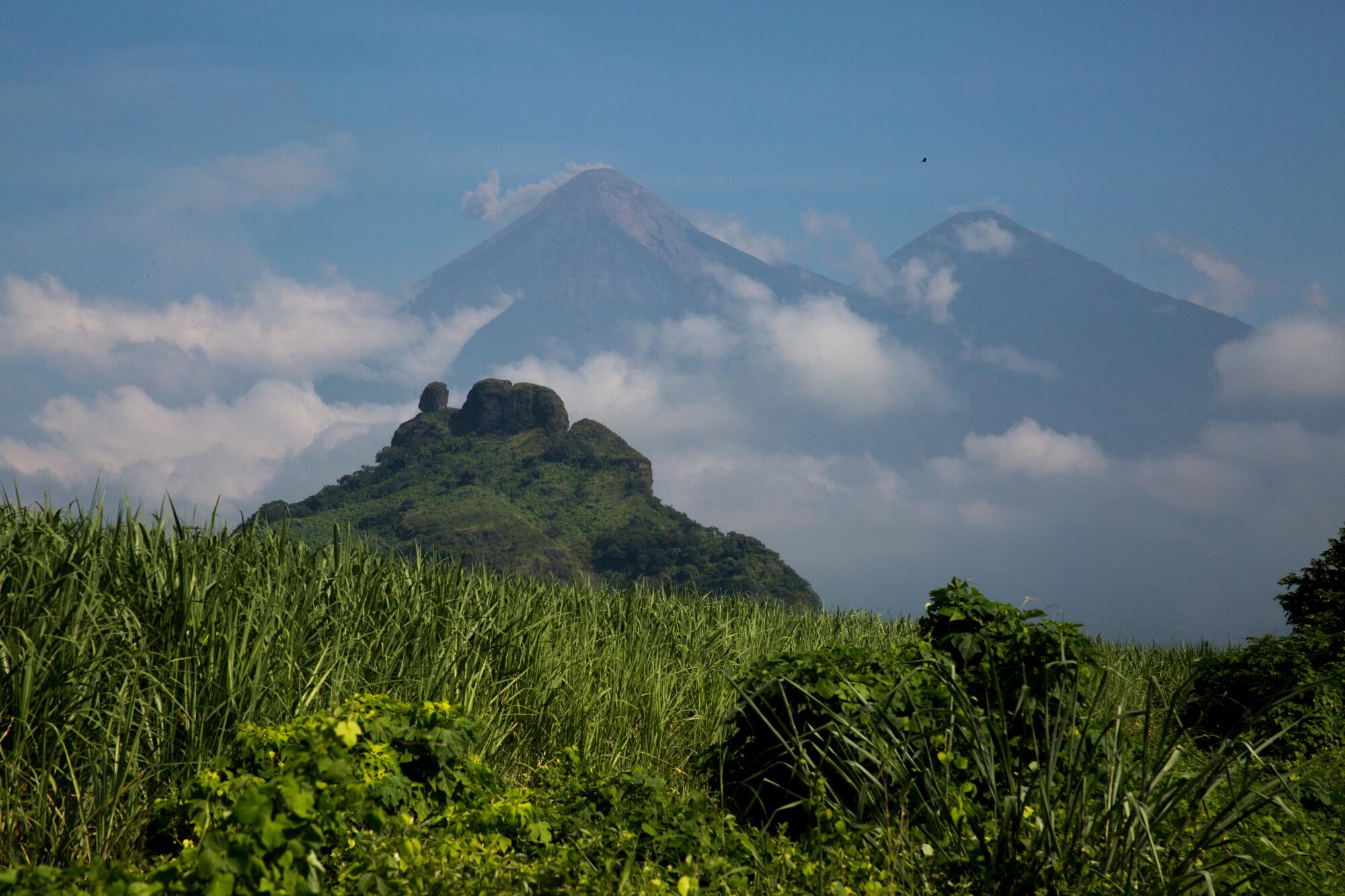
In Escuintla, a view of two of Guatemala’s volcanoes, the active Fuego volcano, left, and the non-active Acatenango volcano to its right.
(James Rodriguez / For The Times)
Regenerative farming is important to Fadul, who says she wishes more producers in her country would use the same sorts of techniques that go beyond sustainable agriculture. Regenerative practices not only maintain the land but rebuild and improve the soil so that it can store more carbon.
Fadul grabs a handful of recently harvested native beans called piloy, admiring their vibrant hues of purple, cream, red and even orange. She smells and tastes the herbs and plants sprouting from the dark soil.
She spots amaranth and caresses the diamond-shaped green leaves, commonly known as pigweed in English.
“Do you know the story about amaranth?” she asks.
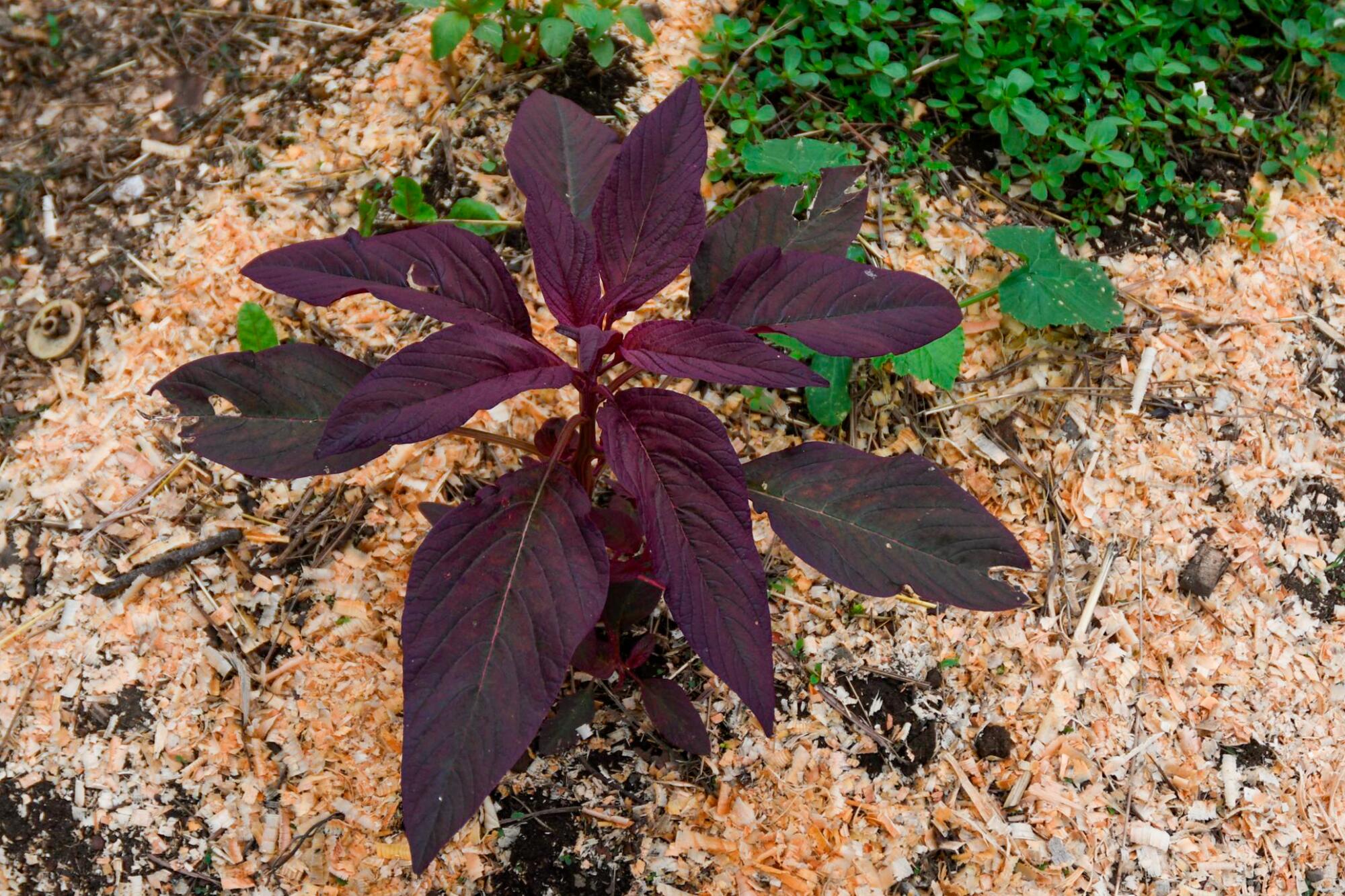
Amaranth planted by organic agriculture educator Erick Torres at his house orchard in San Pedro Las Huertas, Guatemala.
(Johan Ordonez / AFP via Getty Images)
Rich in protein and fiber and often used as a grain, amaranth seeds were a staple of many Indigenous people’s diets in Guatemala. When the Spanish arrived, they noticed its importance — not only for its nutritional value, which is on par with spinach, but for its use in spiritual ceremonies.
This is why the Spanish, who arrived in the 1500s and set out to control the people by converting them to Catholicism, banned the cultivation and possession of the crop, which fell into disuse. They also nicknamed the amaranth seed “bledo.”
This is where the expression “Me importa un bledo” (I don’t give a damn) originates.
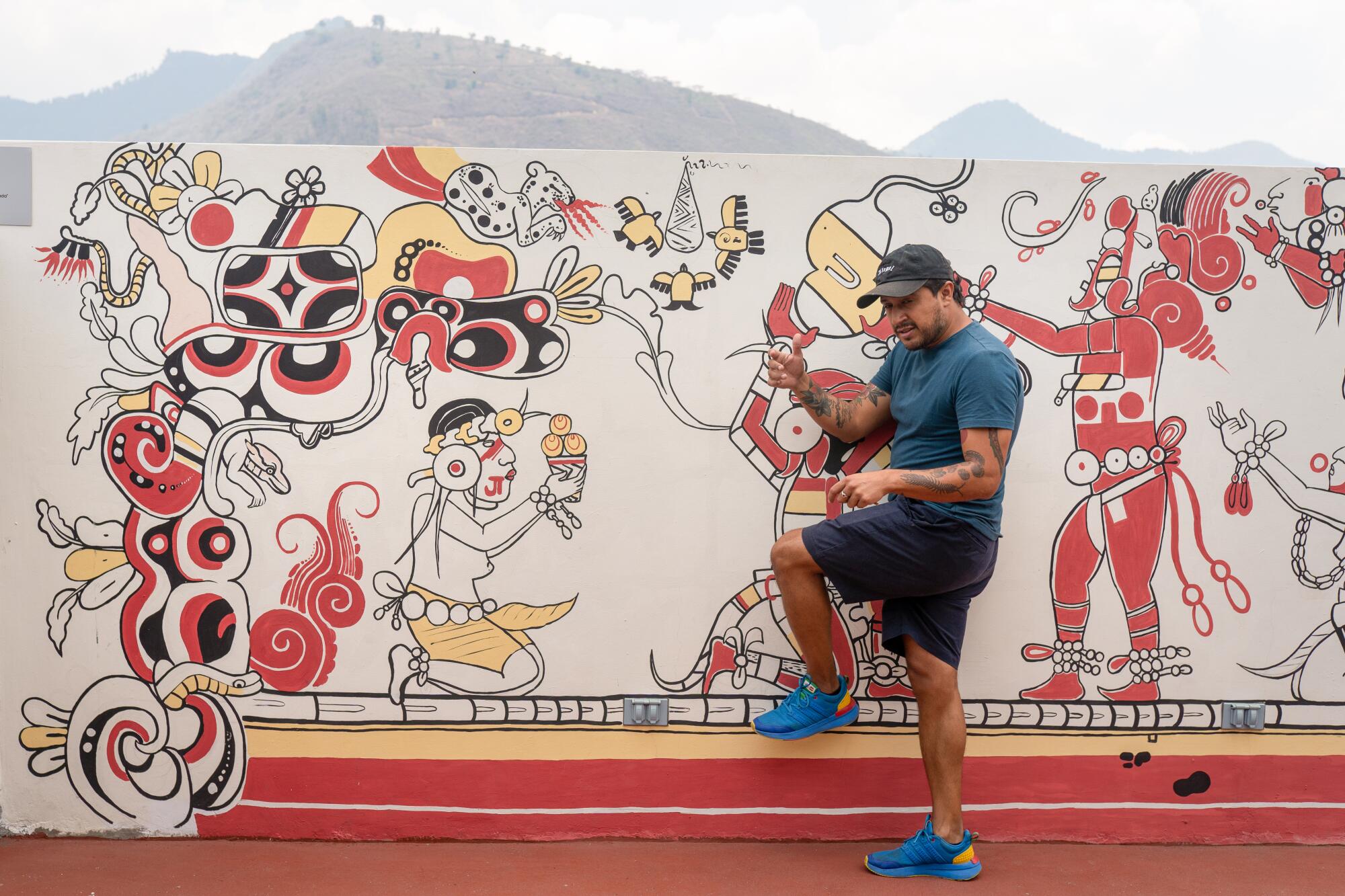
Juan Pablo Romero mimics the action in a mural at El Patojismo that resembles a Mayan Codex. Romero is the founder and head of El Patojismo, an alternative educational center for low-income urban youth.
(James Rodriguez / For The Times)
“The Spanish discovered that the easiest way to conquer us was via our food,” Fadul tells the group. “They made us feel as though what we had here didn’t have any value.”
Centuries after the Spanish invasion, the Indigenous ingredients that remained in Guatemala were almost obliterated by waves of immigrants, conflict and globalization that brought new ingredients and cooking practices.
Amaranth faced near-extinction in Guatemala during the civil war that raged in the country for 36 years until 1996 and left more than 200,000 dead — the majority Indigenous Guatemalans. But it wasn’t just the people who bore the brunt of the war; it was also Indigenous culture and food practices.
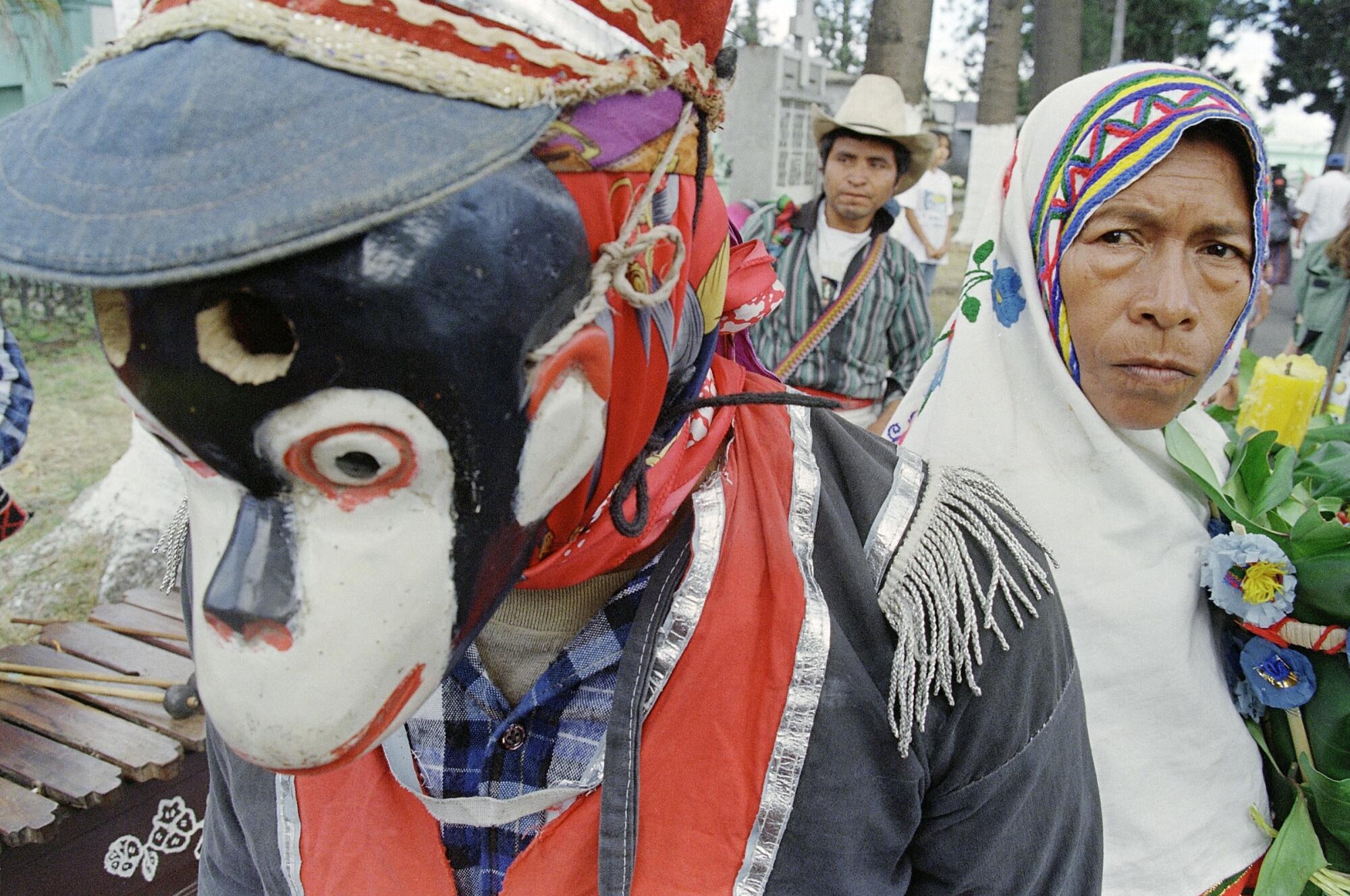
People take part in a ceremony marking the end of the Guatemalan civil war.
(Jorge Uzon / AFP via Getty Images)
State forces looking to defeat insurgents often targeted Indigenous villages and burned their agricultural fields.
Mass displacement of Indigenous people during the conflict led to a knowledge gap and a disconnect between generations, according to the Food and Agriculture Organization of the United Nations. Recipes normally handed down from mother to daughter were lost and levels of poverty and malnutrition skyrocketed. Processed foods replaced locally grown produce, such as the beans grown by Matea Gonzalez, a 54-year-old farmer who lives in Parramos, about a 90-minute drive west of Guatemala City.
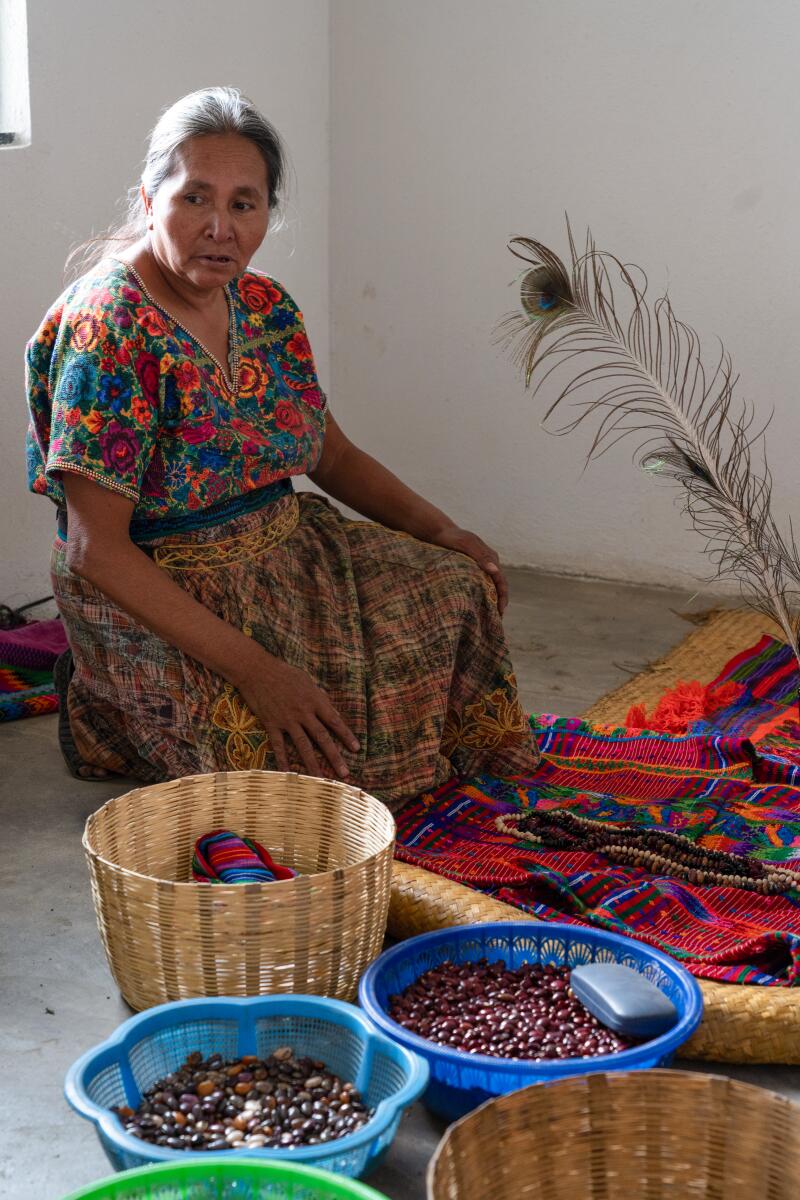
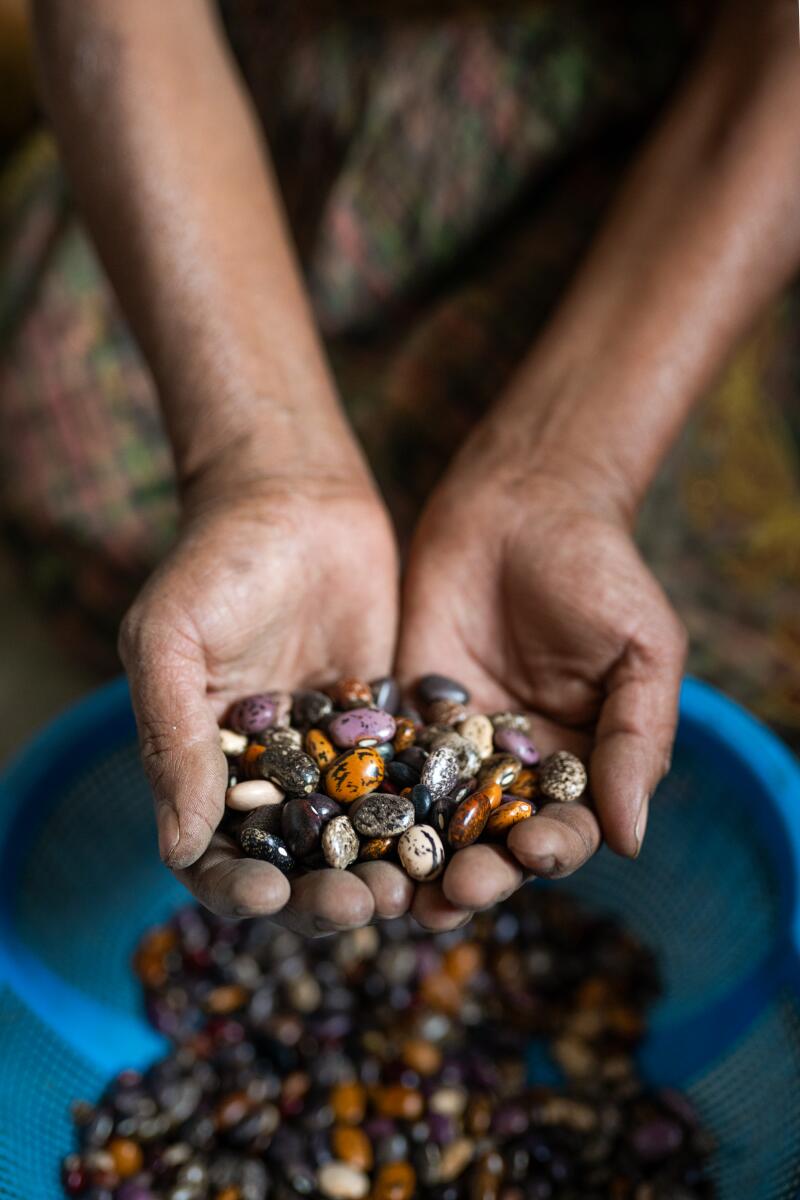
Maria Matea Gonzalez, Kakchiquel Mayan bean producer, at home with her harvest and homemade textiles, top, and holding recently harvested multicolored Piloy beans. (James Rodriguez / For The Times)
Fadul greets Gonzalez with a basket of fresh vegetables from other producers — beets, radishes, peppers and macuy, a wild herb native to Guatemala that’s considered a superfood.
Gonzalez escorts Fadul into a newly constructed room. It’s sparse except for nearly a dozen straw and plastic baskets on the floor, each filled with heirloom beans or corn kernels.
“Doña Matea, your beans are just beautiful,” Fadul tells her. “They are spectacular.”
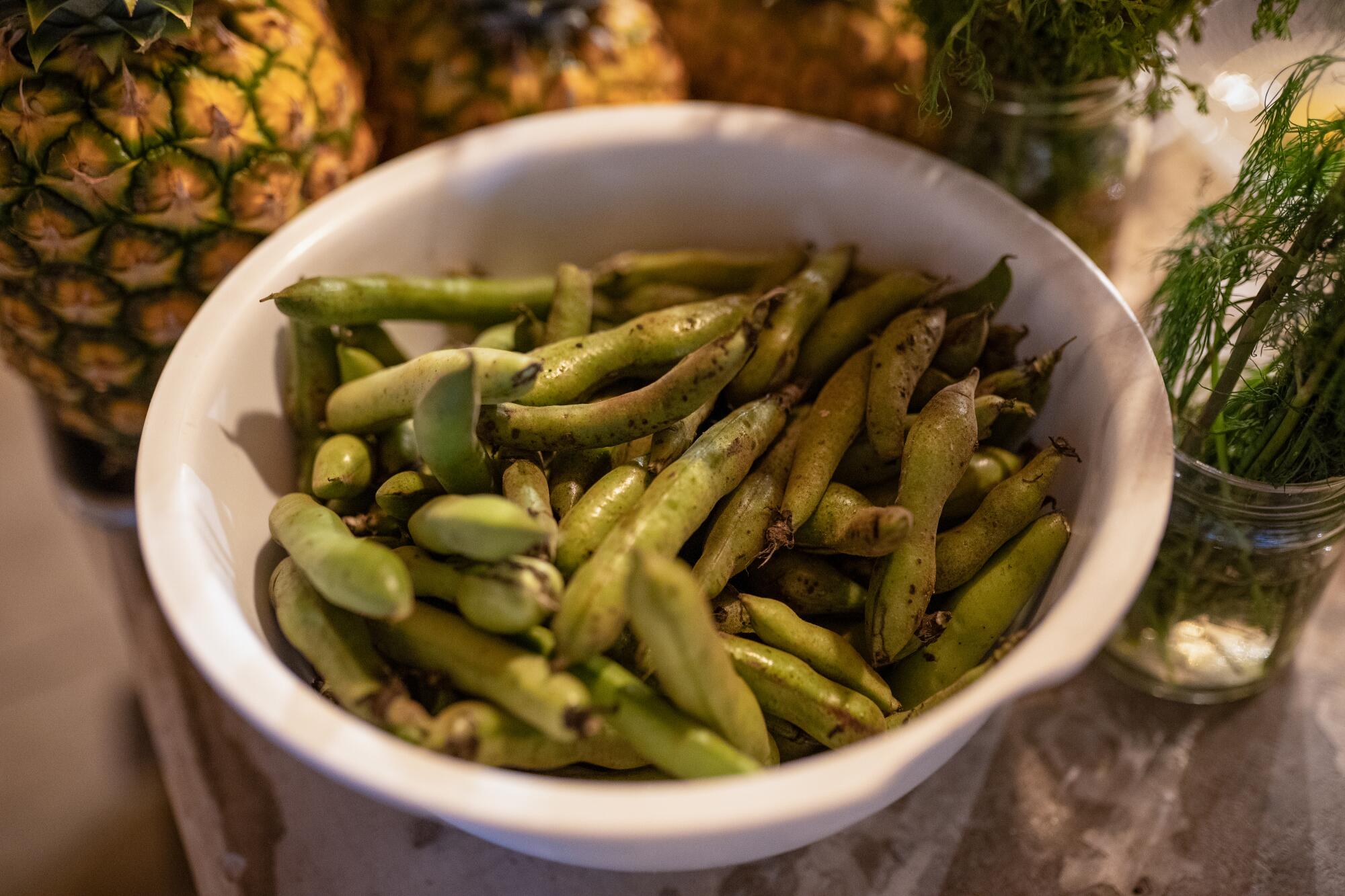
Bean pods in a bowl at Diaca Restaurant.
(James Rodriguez / For The Times)
She runs her fingers though a basketful of small white beans called “perla del suelo” — pearl of the ground — adorned with vein-like lines. It’s an heirloom bean native to Guatemala.
“These are my favorites,” Fadul says with her infectious smile.
Gonzalez, a devout Catholic who wears traditional Indigenous garb and speaks the Mayan language of Kaqchikel, places some of her best produce in smaller baskets on top of an altar she erected to thank God for the harvest.
“I really do appreciate your support,” she tells Fadul in Spanish. “You give me a fair price.”
Gonzalez normally sells her beans to an intermediary who will pay about 5 quetzales — approximately 64 U.S. cents — per pound. After she factors in the cost and labor of producing the beans, she makes only about 2 quetzales — about 25 cents — in profit per pound.
In Guatemala City, you’ll find the same bean for 45 quetzales — nearly $6 — a pound at a grocery store.
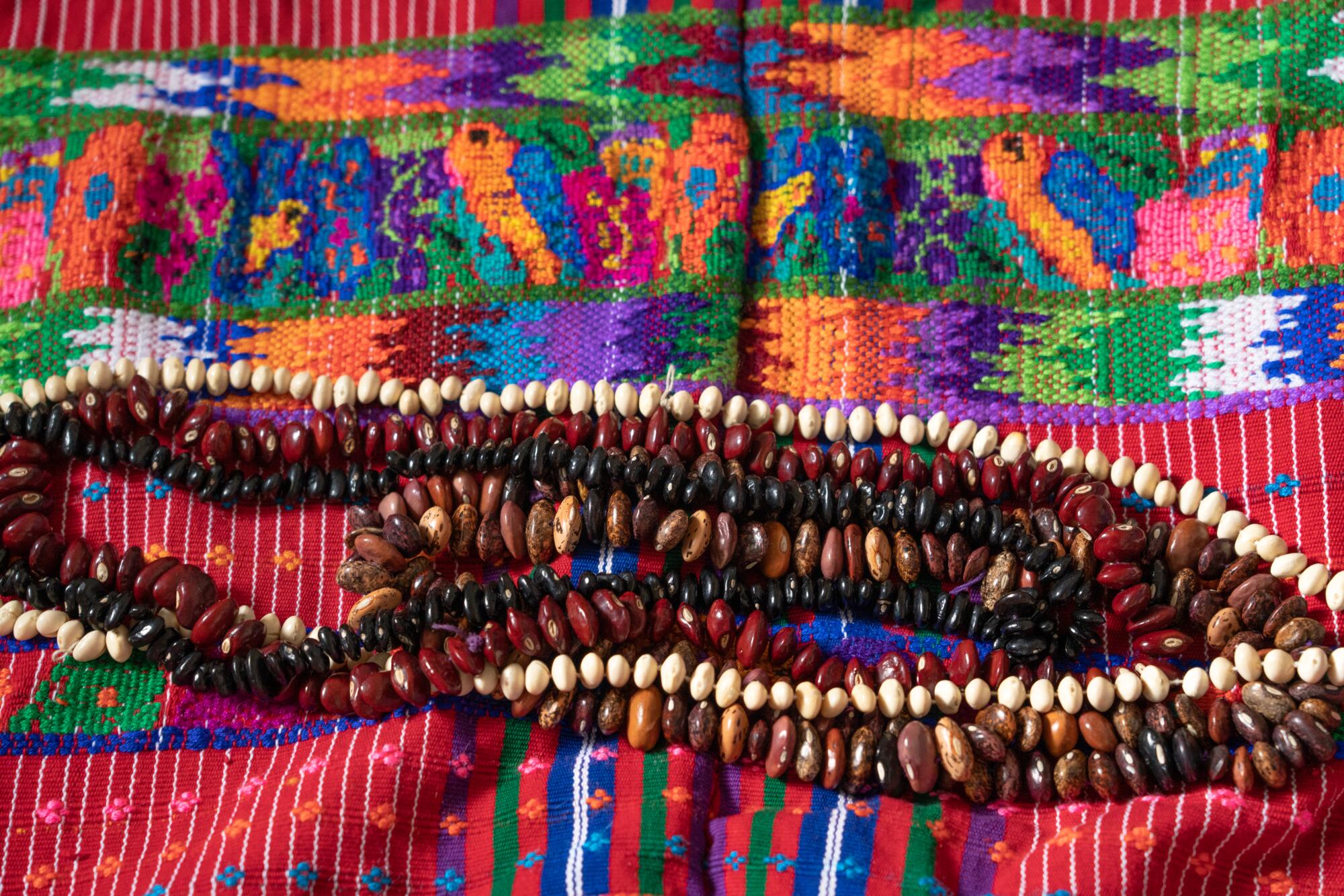
Necklaces made from beans on a homemade guipil, or traditional Guatemalan blouse, at the home of Maria Matea Gonzalez.
(James Rodriguez / For The Times)
“This is the reality of all the producers,” Fadul says, “from those who grow flowers to coffee and corn. All producers.”
It’s one of the reasons Fadul pays double the middleman’s price for Gonzalez’s beans.
Her goal is to make farmers like Gonzalez proud of what they produce and give value to what they grow — to give them a voice in their country.
Just as important is getting diners and home cooks to appreciate what their country can produce. The average Guatemalan has forgotten or never knew about many native ingredients such as Gonzalez’s heirloom beans .
This is why Fadul teaches cooking classes at El Patojismo, an alternative educational center for low-income urban youth. She also created a searchable digital database of Guatemalan producers called Crece en Guate (Grown in Guatemala). The website gives producers visibility and provides a way for consumers to make contact and buy directly from the farmers.
At her own restaurant, she and her team work with farmers, archaeologists and biologists to explore the biodiversity of Guatemala. She sources from more than 45 food producers and showcases the ingredients in a fixed menu at Diacá.
Fadul says she never tells a farmer or rancher what she needs.
Instead, she asks: “What do you have?”
And with that, she builds a menu.
In the restaurant
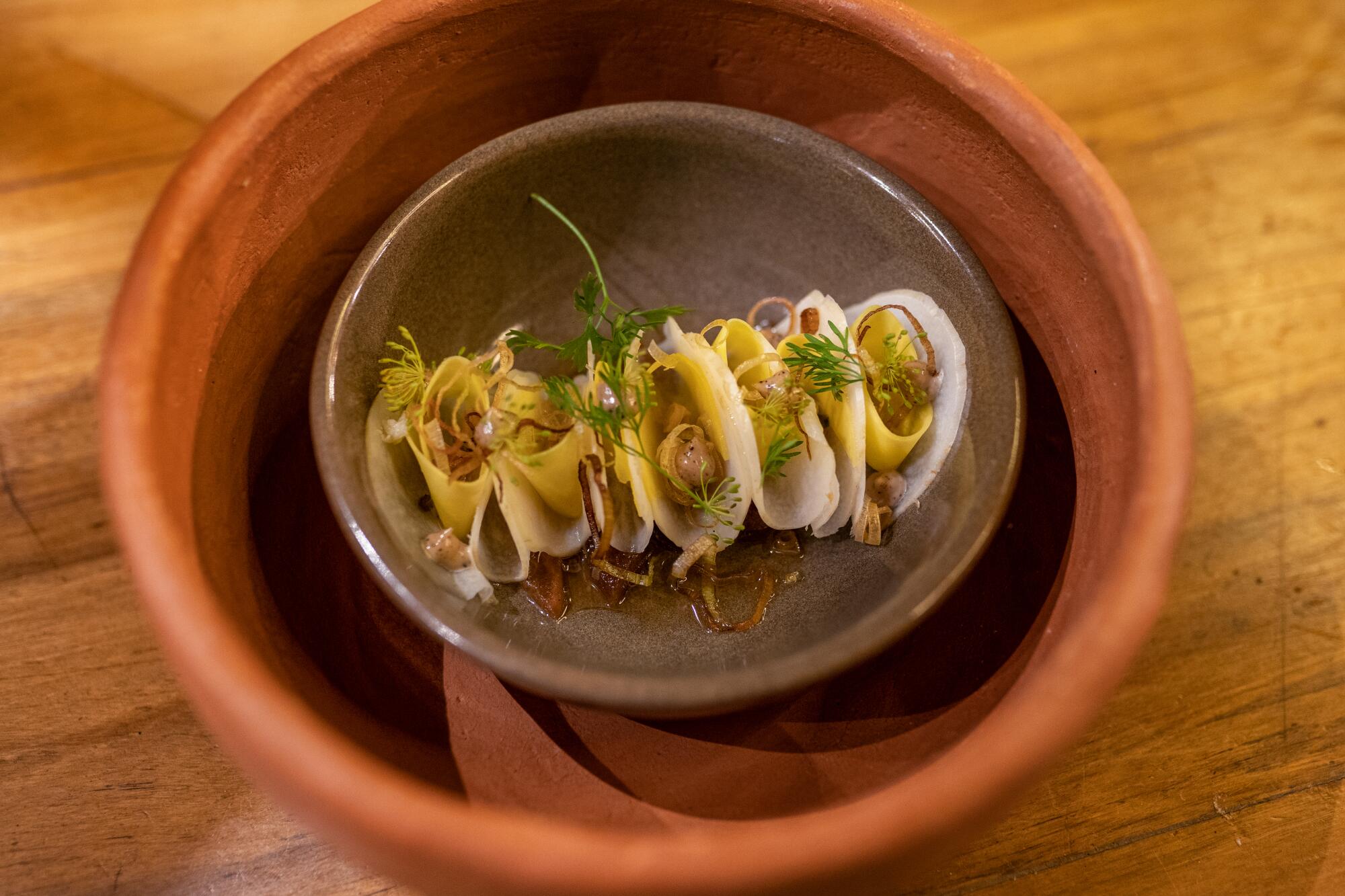
At Diacá, red snapper with mango and perulero.
(James Rodriguez / For The Times)
Born and raised in a middle-class family in Guatemala, Fadul never thought about leaving Guatemala for culinary training abroad.
After graduating from Camille Escuela de Alta Cocina in Guatemala City, she launched a catering company called Chef de Mon Coeur in 2008. That venture allowed her to explore various ingredients in the country and helped her promote Guatemalan gastronomy. She also had a seasonal pop-up concept where she put together gastronomic experiences around the city and the countryside.
In 2018, she opened Diacá. The name, a sly misspelling of “de acá,” which means “from here” in Spanish, reflects Fadul’s playful and purposeful mission.
Perched on the rooftop terrace of a midcentury building in the hip neighborhood of Cuatro Grados Norte, Diacá has become something of a refuge from the hustle and bustle of Guatemala City. Most diners share a single table encircled by transparent glass walls. It’s a small space that can seat only about two dozen diners at a time.
The restaurant’s vibe is the opposite of formal. Most if not all of the staff of about 10 are younger than 40. The guests appear to be well-heeled and can afford the 450 quetzales — about $55 — for the eight-course tasting menu, which varies depending on the season and what producers have available. There’s also an 11-course menu for about $75.
New diners don’t quite know what to expect before they step foot in the restaurant but are put at ease when welcomed by a friendly member of the team. Eating here is a sometimes emotional experience for locals, who may taste an ingredient their mother or grandmother once used to create a beloved dish. Only now it’s prepared a bit differently.
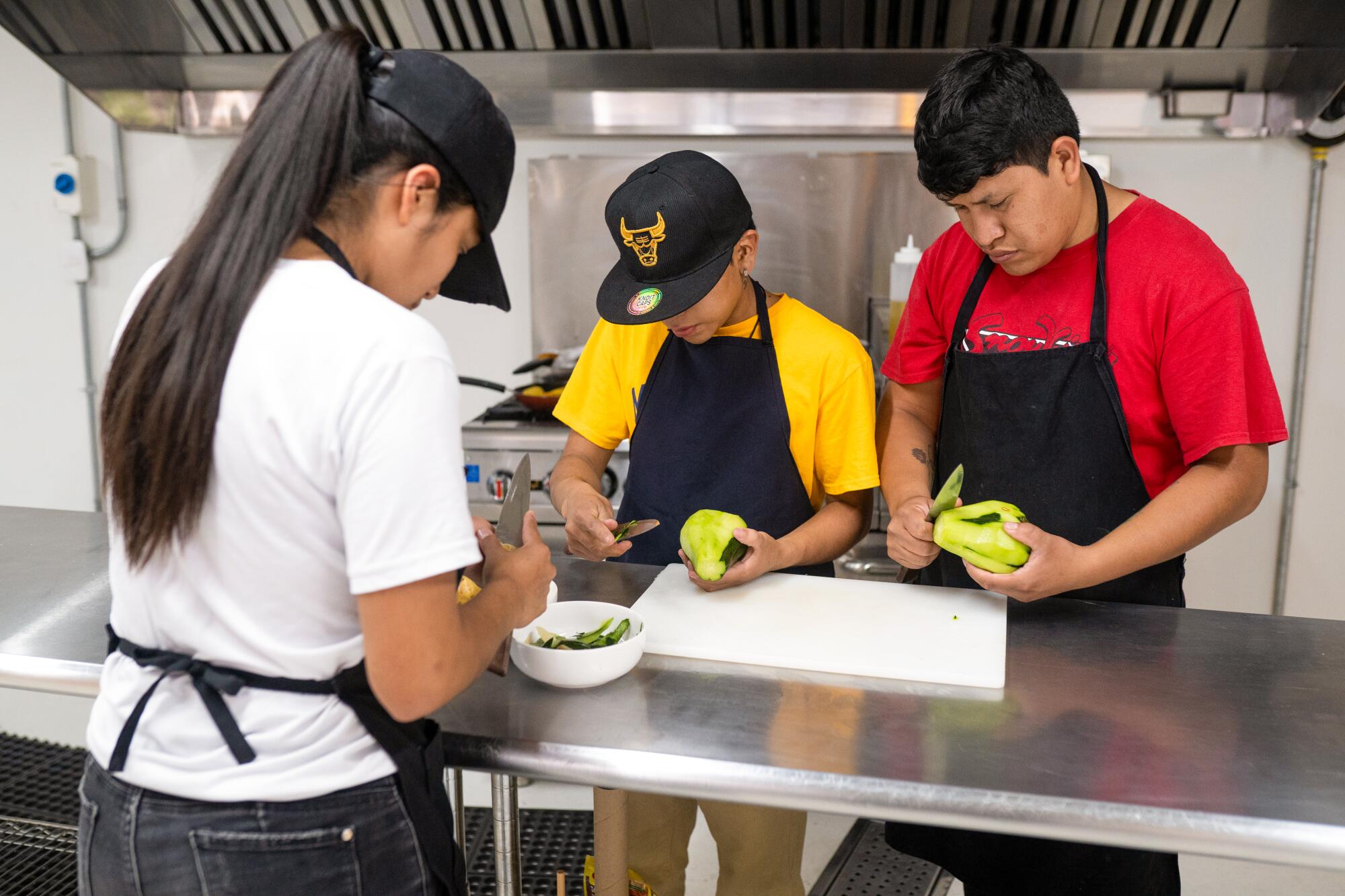
Cooking students Yustina Quina, left, Paulino Alquijay and Andy Alquijay peel güisquil at the cafeteria in El Patojismo, an alternative educational center for low-income urban youth.
(James Rodriguez / For The Times)
For instance, the green, pear-shaped squash called güisquil — also known as chayote — is native to Mesoamerica and commonly boiled and used in soups or stews. But on one spring evening, Fadul and her team served thin slices of the raw fruit, which tastes like a cross between jicama and cucumber.
One Guatemalan diner was overwhelmed when she took a bite.
“I know this flavor,” she says. She couldn’t quite place it.
“It’s güisquil,” says Manuel Montepeque, 26-year-old head bartender and program director at the restaurant.
Her eyes roll back into her head and she grins with glee.
“I’ve never had güisquil like this before,” she says.
After giving a lengthy explanation of the latest course — the ingredients, the regions and producers — Montepeque returns to his cocktail making. Moments later, he‘s helping in the kitchen — an open room behind an island where you can clearly see everything. Mostly everyone has a role or specialty, but everyone trains to do a little bit of everything.
“That’s the way it is here,” Fadul explains. “Everyone here washes dishes, including myself.”

Diacá bar manager and program director Manuel Montepeque prepares drinks with local Guatemalan fruits, including jocote and mamey.
(James Rodriguez / For The Times/James Rodriguez/Los Angeles Times)
Fadul doesn’t run her kitchen in the classical French way. She doesn’t care much for the ingrained hierarchy and seriousness of it. The main objective is to respect the ingredients and the people you work with.
“There has to be love and happiness in the food you make,” she says. “If you don’t have that, the consumer will notice it. You transfer that energy with what you make.”
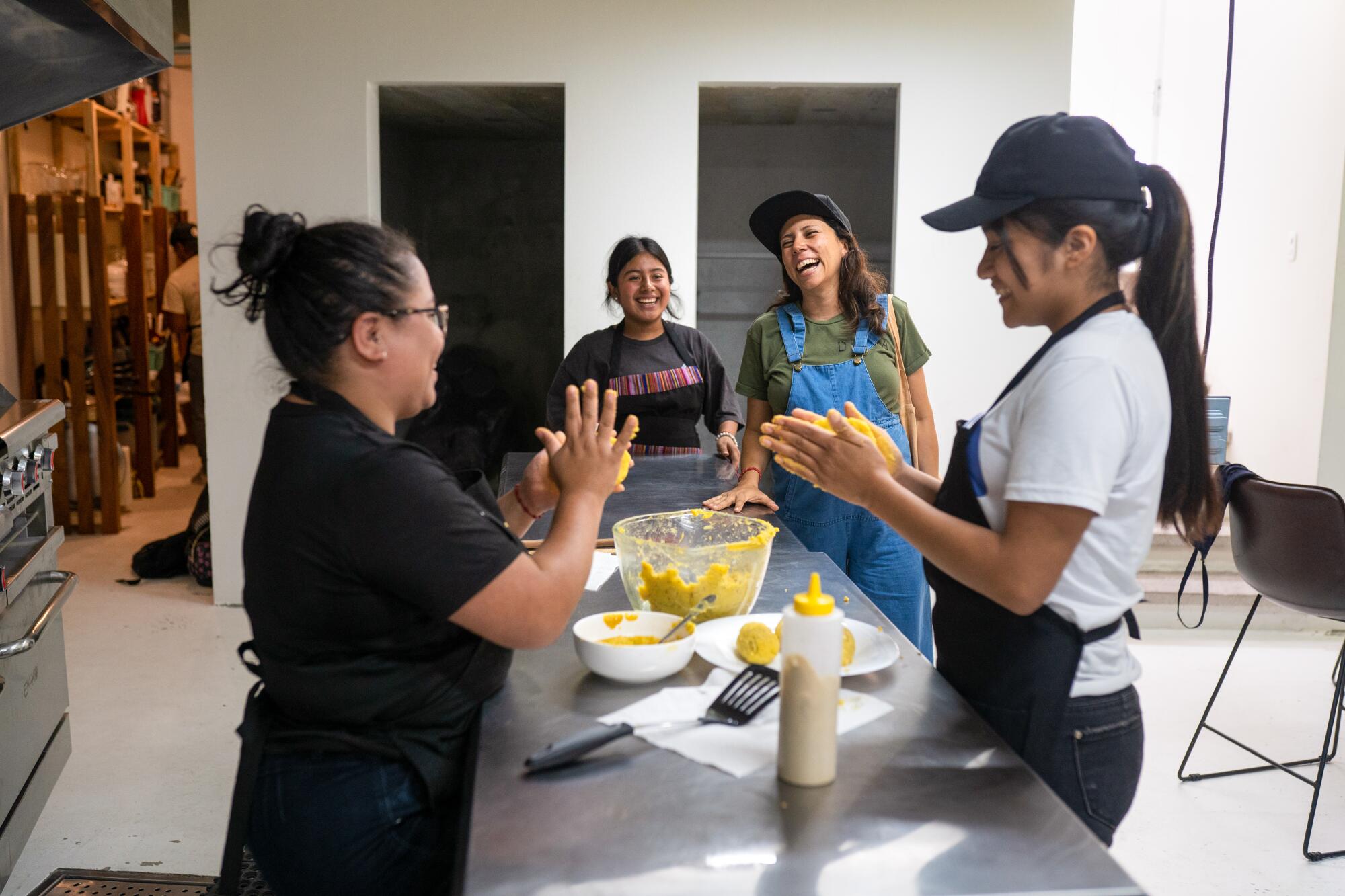
Chef Debora Fadul, in overalls, laughs with staff and students at the cafeteria in El Patojismo, an alternative educational center for low-income urban youth.
(James Rodriguez / For The Times)
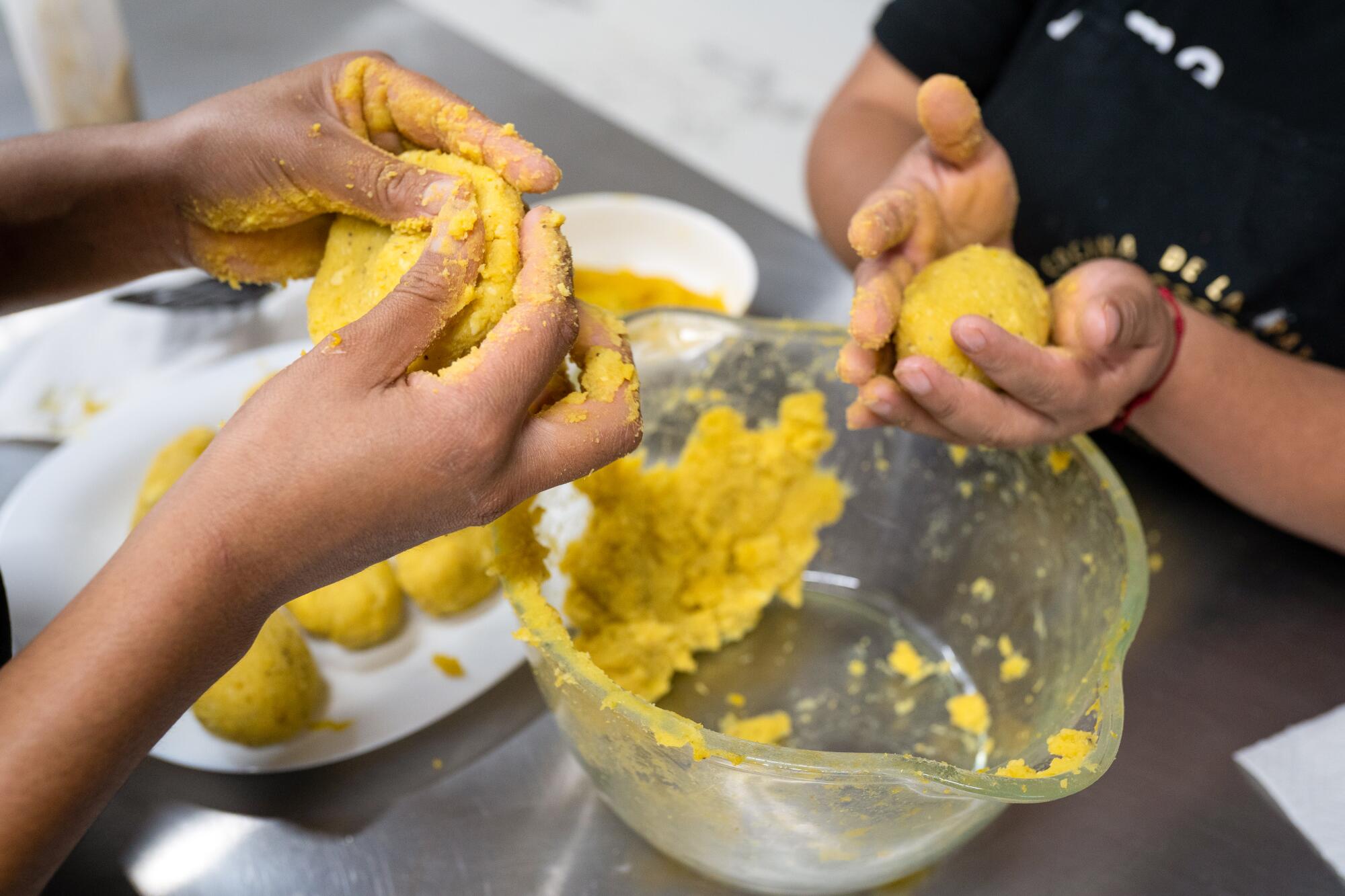
Kitchen staff at the cafeteria in El Patojismo make an alternative version of rellenitos, a traditional Guatemalan snack made from smashed plantains and filled with sweet bean paste. In this version, the rellenitos are filled with sweet cornmeal and dressed with a pumpkin seed sauce.
(James Rodriguez / For The Times)
Fadul and her teammates laugh and share stories as they cook. On that evening, Fadul styled her hair back with a scarf — one of many that belonged to her grandmother, who was a cook and inspired her to do the same.
Some of the diners seem starstruck when they meet her, commending her on what they’ve just eaten. She stresses that her team and the producers deserve the recognition. That mantra is something the team takes seriously.
“Here, the star isn’t the chef,” Montepeque tells a couple who showers Fadul with praise. “The stars here are the producers, the ingredients and where they come from.”


